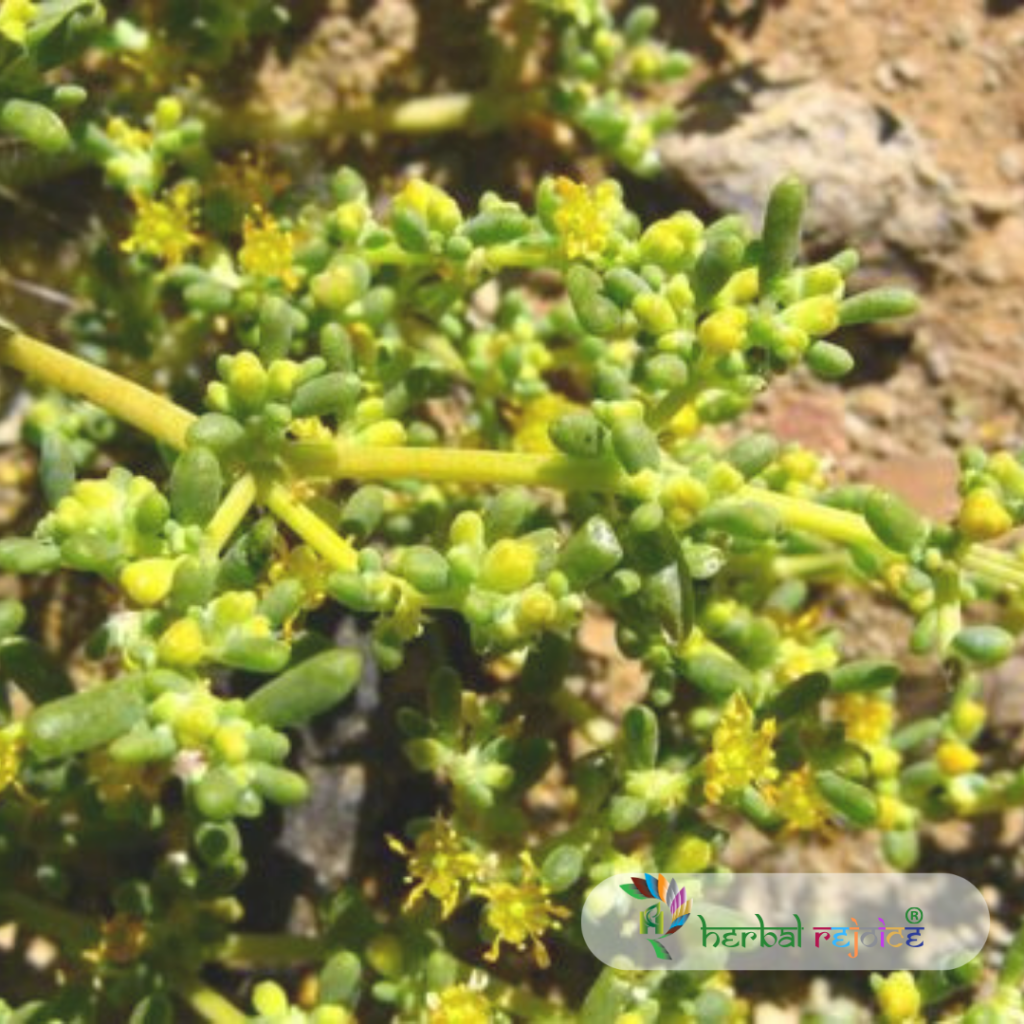Introduction
Zygophyllum simplex Linn., also known as Alethi (in Punjab) or Lunio and Lunwaa (in Rajasthan), is a plant that can be found in the arid and sandy tracts of Punjab, Rajasthan, and Gujarat.
Medicinal Uses
Treatment of Ophthalmia and Glaucoma
Traditionally, an infusion made from the leaves and seeds of Zygophyllum simplex is used to treat ophthalmia and glaucoma. The infusion is applied to the eyes to provide relief from these conditions.
Anthelmintic Properties and Worm Expulsion
The seeds of the plant have anthelmintic properties, helping to expel intestinal worms.
Skin Cleansing and Health Benefits
In addition to its medicinal uses, Zygophyllum simplex can also be used as a skin cleanser. Infusing the leaves in water creates a cleansing solution that can be used to improve the condition of the skin. The plant also contains free ascorbic acid, which is a form of vitamin C that has antioxidant properties. This nutrient can help protect the skin from oxidative damage and improve overall skin health.

Components of Zygophyllum simplex
Key Compounds Identified
Recent studies have identified an acylated glycoside in the aerial parts of Zygophyllum simplex. Other compounds found in the plant include isorhamnetin, its 3-O-glucoside, kaempferol-3-O-rutinoside, sitosterol glucoside, and quinovic acid-3 alpha-L-rhamnoside.
Acylated Glycosides and Their Benefits
These compounds contribute to the plant’s medicinal properties and may have additional health benefits.
Flavonoids: Kaempferol and Quercetin
Zygophyllum simplex also contains flavonoids such as kaempferol and quercetin, with quercetin being found in higher amounts in the fruits. Flavonoids are known for their antioxidant and anti-inflammatory properties, which can benefit overall health and wellbeing.
Applications and Benefits
Traditional Remedies and Their Efficacy
Zygophyllum simplex has been traditionally used to treat eye conditions and intestinal worms, showcasing its significance in traditional medicine.
Modern Uses in Skin Care
The plant’s skin-cleansing properties and antioxidant content offer modern applications in skincare, highlighting its versatility.
Potential Health Benefits Beyond Traditional Uses
Beyond its traditional uses, the plant’s compounds suggest potential benefits for general health and wellness.
Conclusion
Zygophyllum simplex Linn. is a valuable plant found in the arid and sandy tracts of Punjab, Rajasthan, and Gujarat. Its leaves and seeds have been traditionally used to treat eye conditions and intestinal worms. The plant contains various compounds, such as acylated glycoside, isorhamnetin, kaempferol-3-O-rutinoside, sitosterol glucoside, and quinovic acid-3 alpha-L-rhamnoside, which contribute to its medicinal properties. Additionally, Zygophyllum simplex can be used as a skin cleanser and contains beneficial flavonoids like kaempferol and quercetin. Incorporating this plant into a skincare routine or using it for its medicinal properties can provide numerous health benefits.
—
Frequently Asked Questions
What is Zygophyllum simplex Linn.?
A medicinal plant found in Punjab, Rajasthan, and Gujarat.
What are its traditional uses?
Treating eye conditions and expelling intestinal worms.
How is it used for eye conditions?
An infusion of its leaves and seeds is applied to the eyes.
What is its anthelmintic property?
Seeds help expel intestinal worms.
What key compounds are in Zygophyllum simplex?
Acylated glycoside, isorhamnetin, kaempferol-3-O-rutinoside, sitosterol glucoside, and quinovic acid-3 alpha-L-rhamnoside.
How does it benefit the skin?
Used as a skin cleanser and contains antioxidant vitamin C.
What flavonoids are present?
Kaempferol and quercetin.
What is the role of quercetin?
Provides antioxidant and anti-inflammatory benefits.
Where is Zygophyllum simplex found?
In arid and sandy regions of Punjab, Rajasthan, and Gujarat.
What are its effects on ophthalmia and glaucoma?
Provides relief when applied as an infusion.
How is the skin cleanser made?
By infusing leaves in water.
What other medicinal properties does it have?
Anti-inflammatory and antioxidant.
How does it protect the skin?
With antioxidant properties from vitamin C.
What is isorhamnetin?
A compound contributing to its medicinal effects.
What is kaempferol-3-O-rutinoside?
A flavonoid with health benefits.
What is sitosterol glucoside?
A compound that supports its medicinal properties.
What is quinovic acid-3 alpha-L-rhamnoside?
A beneficial compound found in the plant.
How does Zygophyllum simplex help with worms?
Its seeds act as anthelmintic.
What is its use in traditional medicine?
For eye treatments and worm expulsion.
What are the health benefits of its flavonoids?
Antioxidant and anti-inflammatory effects.


